88nine, RadioMilwaukee, started broadcasting in its new format this week. I have to wonder if Milwaukee's ready for two independent radio stations.
I'm a huge fan of WMSE, the city's alternative station for many years. They've hooked me on Americana, Latino, rockabilly, and soul, and furthered my fondness for blues, old rock, and pop of many flavors. I swear by the Chicken Shack and Way Back Home.
That said, WMSE often isn't terribly radio-friendly. Their willingness to push boundaries and expectations often means they'll play stuff that is a turn-off to someone who wants to listen to "good music" and doesn't want to hear "Hotel California" for the ten thousandth time -- be it screechy Indian pop, screaming hardcore metal, broken-voiced primative folk music, or painfully unmelodic and atonal free jazz. (WMSE has taught me to hate free jazz.)
In the evenings, Milwaukee's NPR affiliate, 89.7 WUWM, also offers music in a similar vein of "diverse but appoachable pop", but it's often rather low key and... well... boring. Saturday at the Cafe used to drive me nuts. I wanted to call them up and yell at them: "It's SATURDAY!! It's the best time of the week! It's a happy time! It's beautiful and sunny outside! PLAY SOMETHING PEPPY!!!" The syndicated World Cafe plays good music but frequently diverges into 15-20 minute interviews which get very annoying if you just want some background music. So while I appreciate WUWM, I've never fallen in love with it as I have WMSE.
This new station seems to be pushing to grab those listeners who like diversity but aren't always up for WMSE's often challenging playlists, and want a bit more zing than WUWM is willing to offer. In that, they sound much like Philadelphia's 88.5 WXPN, creators of the World Cafe. It's a format that I've long hoped would find commercial success, but I'll accept this instead.
So far, I don't think WMSE and RadioMilwaukee are really in direct competition with each other; WMSE's format focuses more on intense exploration of various genres, whereas this new station seems more about maintaining a relatively even keel, touching on a bit of this, a bit of that. It suits people who might like reggae or hip hop, but don't want to sit through three solid hours of it. They're different approaches. I just hope that it will expand the base of member-supported listeners, rather than drawing away WMSE's base.
I wonder how long Milwaukee can support two independent radio stations. Few cities are so lucky. Enjoy it while it lasts, folks.
Wednesday, February 28, 2007
Some recent stories of interest:
- Riverwest Currents reports on progress at the North Avenue reservoir, which is being taken apart and rebuilt into park space. I drive past this thing going to and from work, and keep meaning to write something about it, but they say more than I could -- and have better photos to boot.
- A Whitney Gould column reflects on opposition to construction projects and how it can negatively impact developers' ability to do work in the city... as well as the quality of the final product.
- From the Journal-Sentinel, the 11-story condo has cleared another hurtle with approval from a review panel of the Common Council.
- From the Shepherd-Express, two differing visions of regional rail transit around Milwaukee.
- Riverwest Currents reports on progress at the North Avenue reservoir, which is being taken apart and rebuilt into park space. I drive past this thing going to and from work, and keep meaning to write something about it, but they say more than I could -- and have better photos to boot.
- A Whitney Gould column reflects on opposition to construction projects and how it can negatively impact developers' ability to do work in the city... as well as the quality of the final product.
- From the Journal-Sentinel, the 11-story condo has cleared another hurtle with approval from a review panel of the Common Council.
- From the Shepherd-Express, two differing visions of regional rail transit around Milwaukee.
Wednesday, February 21, 2007
Blegh! I biked to work today, taking advantage of temperatures around freezing. After three weeks of temps see-sawing around zero, it felt absolutely tropical.
Sadly, there's a month's worth of muck on the roads, well-stirred by the intense humidity of melting snow. By the time I got to Brady Street, I had half of Wisconsin splattered on my bike and myself.
Also: those condos on N. Prospect still have that botched up pavement in the bike lanes, and again it nearly killed me as I headed home this evening. They've also taken up more of the lane with a construction fence and a pile of shoved-aside snow. Annoying!
Also also: Unrelated to anything urban, the Dirty Dozen Brass Band at Potawatami's Northern Lights Theater were awesome. Happy Mardi Gras!
Sadly, there's a month's worth of muck on the roads, well-stirred by the intense humidity of melting snow. By the time I got to Brady Street, I had half of Wisconsin splattered on my bike and myself.
Also: those condos on N. Prospect still have that botched up pavement in the bike lanes, and again it nearly killed me as I headed home this evening. They've also taken up more of the lane with a construction fence and a pile of shoved-aside snow. Annoying!
Also also: Unrelated to anything urban, the Dirty Dozen Brass Band at Potawatami's Northern Lights Theater were awesome. Happy Mardi Gras!
Monday, February 12, 2007
Milwaukee's Discussion Void
As I skim back over my just-posted take on a St. Louis development proposal, I'm struck by how many links I ended up putting in it. It's amazing how many people in St. Louis are already discussing it, just days after its announcement.
The contrast is stark: I challenge you to find any comparable discussion among the residents of Milwaukee. Apart from this blog, and one or two other bloggers who occasionally touch on issues of urbanism, architecture and development, there's nothing. Silence. A void. There simply is no online community discussing the physical form of Milwaukee or its future. There's Whitney Gould at the Journal-Sentinel, and then nothing.
Granted, Milwaukee can afford to rest on its laurels a bit -- our last Mayor went on to become president of the Congress for the New Urbanism. When Norquist first came to town, he saw a new Walgreens on Brady Street with a ghastly parking lot in front of it. "Why'd you build it like that??" he asked the developer. "'Cause that's what the code says we had to do!" was the answer. So he promptly set about changing the code. Then he tore down the Park East freeway; we're just starting to fill in the 16 acres of downtown land that it opened up. It's Milwaukee's poor fortune that he was unable to tear down the 794 approach to the lake and the Hoan Bridge; replacing it with a surface boulevard would have connected downtown to the 3rd Ward, to the benefit of both.
Now we see the results of all that, as urban buildings are popping up like weeds all over downtown and the East Side.
Milwaukee's damn lucky that way. In St. Lous, outdated zoning laws mean that every last bit urbanism must be fought for, tooth and claw. It's a case-by-case battle, never-ending and often lost. In Milwaukee, people complain because our neighborhood density is increasing. But we don't know how good we've got it.
The contrast is stark: I challenge you to find any comparable discussion among the residents of Milwaukee. Apart from this blog, and one or two other bloggers who occasionally touch on issues of urbanism, architecture and development, there's nothing. Silence. A void. There simply is no online community discussing the physical form of Milwaukee or its future. There's Whitney Gould at the Journal-Sentinel, and then nothing.
Granted, Milwaukee can afford to rest on its laurels a bit -- our last Mayor went on to become president of the Congress for the New Urbanism. When Norquist first came to town, he saw a new Walgreens on Brady Street with a ghastly parking lot in front of it. "Why'd you build it like that??" he asked the developer. "'Cause that's what the code says we had to do!" was the answer. So he promptly set about changing the code. Then he tore down the Park East freeway; we're just starting to fill in the 16 acres of downtown land that it opened up. It's Milwaukee's poor fortune that he was unable to tear down the 794 approach to the lake and the Hoan Bridge; replacing it with a surface boulevard would have connected downtown to the 3rd Ward, to the benefit of both.
Now we see the results of all that, as urban buildings are popping up like weeds all over downtown and the East Side.
Milwaukee's damn lucky that way. In St. Lous, outdated zoning laws mean that every last bit urbanism must be fought for, tooth and claw. It's a case-by-case battle, never-ending and often lost. In Milwaukee, people complain because our neighborhood density is increasing. But we don't know how good we've got it.
Saturday, February 10, 2007
"We'll never be like Chicago!"
Having lived and debated both north and south of the Windy City, I have heard Chicago brought up many times as an example of how to carry out some particular aspect of urban design and planning. And without fail, somebody will pop up with the stock local pride response: "St. Louis/Milwaukee isn't Chicago! And we shouldn't try to be!"
It drives me crazy, because it completely misses the point.
Chicago, while plagued with the same problems that most Rust Belt cities must deal with, is a highly successful urban environment when compared to most American cities. It packs considerable population density across a large area, enough to support a busy and thriving mass transit system. The rail portion of that system succeeds because it runs so frequently that it's a viable alternative to driving. It's desirable not to drive because things are so dense, parking so scarce. Things are dense because a large volume of historic buildings have been preserved, and where they have been destroyed they've been replaced by buildings of greater density. It has both major chains and small local stores. It has a diversified economy, fueled by this variety of scales. It has busy street life. It has, in short, all the hallmarks of a true urban environment.
But those are not the trappings of some kind of mythical aura of Chicagoness that if emulated will turn all your citizens into zombie Bears fans. They are the basic requirements of any successful urban environment, regardless of its size. They apply across the board -- in Chicago, in New York, in San Francisco, and yes, in St. Louis and Milwaukee.
Build upon those things, and your city succeeds. Diminish them, work against them, allow developers to build sprawl instead of density, and your city fails.
It is not about becoming Chicago; it is about becoming an urban environment, and Chicago is the closest example one that works. Your city may never "be like Chicago" in whatever other ways you're thinking of (certainly it's unlikely to match Chicago's population), but it would do well to learn some of Chicago's lessons. They transcend any one location.
It drives me crazy, because it completely misses the point.
Chicago, while plagued with the same problems that most Rust Belt cities must deal with, is a highly successful urban environment when compared to most American cities. It packs considerable population density across a large area, enough to support a busy and thriving mass transit system. The rail portion of that system succeeds because it runs so frequently that it's a viable alternative to driving. It's desirable not to drive because things are so dense, parking so scarce. Things are dense because a large volume of historic buildings have been preserved, and where they have been destroyed they've been replaced by buildings of greater density. It has both major chains and small local stores. It has a diversified economy, fueled by this variety of scales. It has busy street life. It has, in short, all the hallmarks of a true urban environment.
But those are not the trappings of some kind of mythical aura of Chicagoness that if emulated will turn all your citizens into zombie Bears fans. They are the basic requirements of any successful urban environment, regardless of its size. They apply across the board -- in Chicago, in New York, in San Francisco, and yes, in St. Louis and Milwaukee.
Build upon those things, and your city succeeds. Diminish them, work against them, allow developers to build sprawl instead of density, and your city fails.
It is not about becoming Chicago; it is about becoming an urban environment, and Chicago is the closest example one that works. Your city may never "be like Chicago" in whatever other ways you're thinking of (certainly it's unlikely to match Chicago's population), but it would do well to learn some of Chicago's lessons. They transcend any one location.
Sunday, February 04, 2007
Milwaukee to Chicago and back
I travel regularly between Milwaukee and Chicago, and have taken to using the train and bus options.
The newly-instituted Megabus has made non-car transit a great deal easier. Their every-few-hours schedule synchs up nicely with Amtrak's, giving travellers a wide array of departure choices.
Price-wise, Megabus stands to give Amtrak a beating. Buy your tickets the day of travel, and it's $9.50 one way; buy a month ahead, and the price drops as low as $3 to $1. Amtrak charges $21 one way, regardless of the time of purchase. $40 for a Chicago day trip has long seemed very steep to me, though perhaps because my basis for comparison is the $24 I used to pay to travel round trip from Philadelphia to New York on regional rail. The Milwaukee area's lack of a regional rail system puts it at a big disadvantage here, and Megabus is stepping in to fill the gap. Even paying for a couple of days' worth of parking at the Milwaukee train station, I still come out way ahead with the bus.
Service-wise... I've had problems with both. Megabus is of course subject to the unpredictable fluctuations of Chicago traffic, which can leave passengers standing at the curbside at length. A bus today was unable to make a return trip, causing a half-hour delay while a replacement arrived; the replacement smelt of exhaust fumes the whole trip back.
Megabus also has an annoying inconsistency with labelling their buses; sometimes a flashing marquee announces the destination, sometimes a printed board, and sometimes... nothing. Today I boarded a bus for Milwaukee whose marquee announced it was bound for Minneapolis. We had to stop and let one guy off who was on the wrong bus.
Amtrak seems just as prone to mechanical difficulties as the bus; one of my last few trips was on a train with a malfunctioning locomotive, causing it to pull in an hour late; another arrived late enough to cause me to miss a Metra connection. Conflicts with freight trains can also cause delays.
Amtrak has the clear leg up when it comes to dignity of service, with full-service stations at each end -- even though both are unfortunate products of the 1960s. The Milwaukee station was long a rather depressing iteration of Modernism:
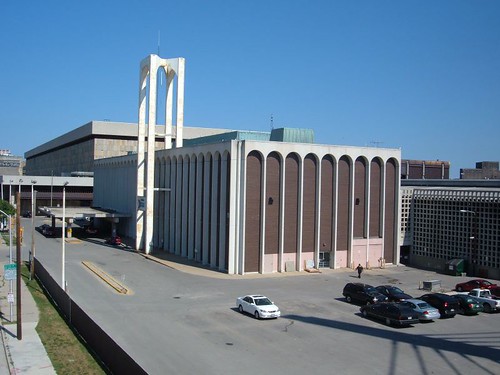
But it is currently undergoing a complete reconstruction:

The rebuilding will provde it with a spacious, light-filled waiting area, replacing a dim, low-ceilinged, dingy space.
Chicago still retains half of its original Union Station:
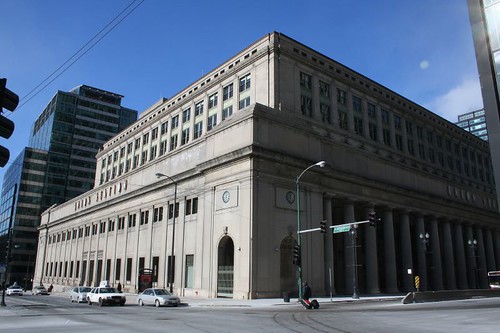
That's the western half, containing its spectular Grand Hall, one of the finest public spaces in the city:
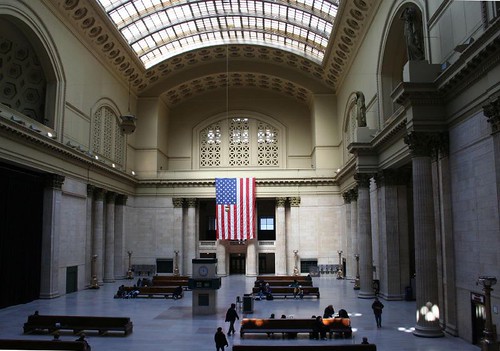
But the concourse to the east, the more heavily-used place where one actually boarded the trains, was replaced by a one-story warren in the 1960s.
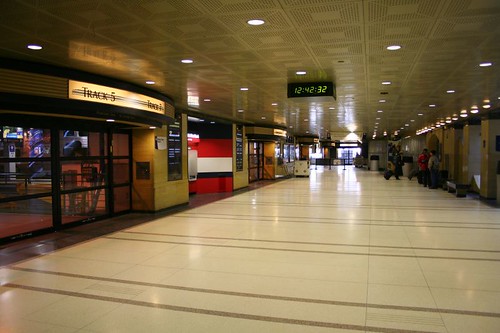
The train shed beyond is singularly unremarkable, a space with absolutely no concessions to nicety, comfort or beauty:
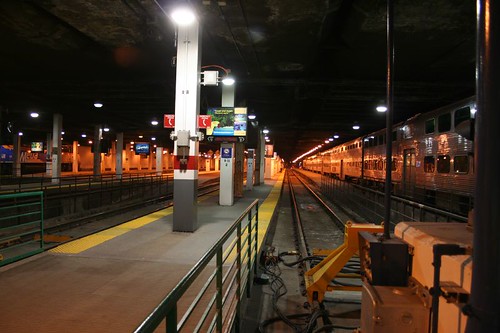
But, at least it keeps the rain off. And the waiting areas are comfortable, if not particularly beautiful.
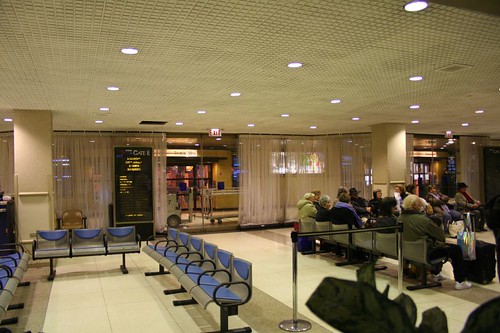
Megabus, by contrast, provides absolutely nothing, picking up passengers at curbside -- up the street from the Amtrak station in Milwaukee, and in the taxi drop-off area in Chicago:
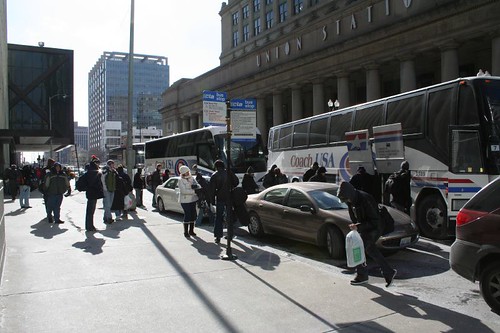
The situation, already chaotic with the comings and goings of taxis, cars, and city buses, is made worst still by the enormous Coach USA buses trying to load and unload crowds of people. Megabus service to Minneapolis, Madison, St. Louis, and elsewhere also departs from here.
Amtrak in Chicago has fired a shot in response to this hijacking of their own facilities by their competition:
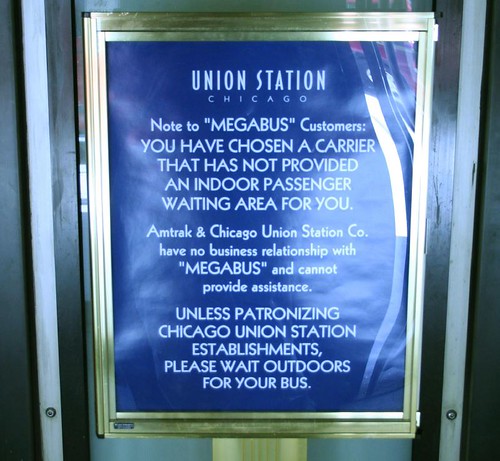
On a February day with a high just barely above zero, Megabus customers don't seem inclined to listen:
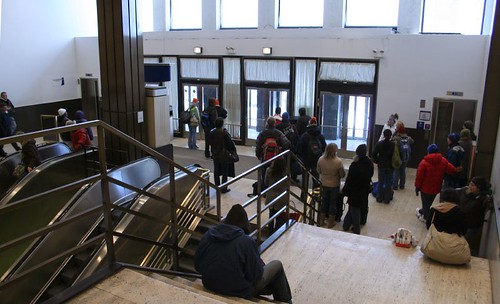
Time-wise... my destination is usually in northern Chicago, which means I have to catch a Metra train and backtrack a ways. All told it tends to add up to about 2.5 - 3 hours, whereas driving it can be as little as 90 minutes.
But whether I'm taking the bus or the train, I find it infinately more enjoyable than driving. When I drive I tend to arrive frazzled, tired, and stressed. When I'm riding, I can read, nap, listen to music, and arrive feeling refreshed. It's also better for the environment.
At any rate, it's good to see Megabus doing a healthy business. I figure that a lot of people would simply drive if Amtrak was their only alternative; this way, they get introduced to the convenience of mass transit, at a price that's affordable. Anything that gets cars off the highway, and promotes the usefulness of mass transit in the eyes of Milwaukee's population, can only be a good thing.
The newly-instituted Megabus has made non-car transit a great deal easier. Their every-few-hours schedule synchs up nicely with Amtrak's, giving travellers a wide array of departure choices.
Price-wise, Megabus stands to give Amtrak a beating. Buy your tickets the day of travel, and it's $9.50 one way; buy a month ahead, and the price drops as low as $3 to $1. Amtrak charges $21 one way, regardless of the time of purchase. $40 for a Chicago day trip has long seemed very steep to me, though perhaps because my basis for comparison is the $24 I used to pay to travel round trip from Philadelphia to New York on regional rail. The Milwaukee area's lack of a regional rail system puts it at a big disadvantage here, and Megabus is stepping in to fill the gap. Even paying for a couple of days' worth of parking at the Milwaukee train station, I still come out way ahead with the bus.
Service-wise... I've had problems with both. Megabus is of course subject to the unpredictable fluctuations of Chicago traffic, which can leave passengers standing at the curbside at length. A bus today was unable to make a return trip, causing a half-hour delay while a replacement arrived; the replacement smelt of exhaust fumes the whole trip back.
Megabus also has an annoying inconsistency with labelling their buses; sometimes a flashing marquee announces the destination, sometimes a printed board, and sometimes... nothing. Today I boarded a bus for Milwaukee whose marquee announced it was bound for Minneapolis. We had to stop and let one guy off who was on the wrong bus.
Amtrak seems just as prone to mechanical difficulties as the bus; one of my last few trips was on a train with a malfunctioning locomotive, causing it to pull in an hour late; another arrived late enough to cause me to miss a Metra connection. Conflicts with freight trains can also cause delays.
Amtrak has the clear leg up when it comes to dignity of service, with full-service stations at each end -- even though both are unfortunate products of the 1960s. The Milwaukee station was long a rather depressing iteration of Modernism:

But it is currently undergoing a complete reconstruction:

The rebuilding will provde it with a spacious, light-filled waiting area, replacing a dim, low-ceilinged, dingy space.
Chicago still retains half of its original Union Station:

That's the western half, containing its spectular Grand Hall, one of the finest public spaces in the city:

But the concourse to the east, the more heavily-used place where one actually boarded the trains, was replaced by a one-story warren in the 1960s.

The train shed beyond is singularly unremarkable, a space with absolutely no concessions to nicety, comfort or beauty:

But, at least it keeps the rain off. And the waiting areas are comfortable, if not particularly beautiful.

Megabus, by contrast, provides absolutely nothing, picking up passengers at curbside -- up the street from the Amtrak station in Milwaukee, and in the taxi drop-off area in Chicago:

The situation, already chaotic with the comings and goings of taxis, cars, and city buses, is made worst still by the enormous Coach USA buses trying to load and unload crowds of people. Megabus service to Minneapolis, Madison, St. Louis, and elsewhere also departs from here.
Amtrak in Chicago has fired a shot in response to this hijacking of their own facilities by their competition:

On a February day with a high just barely above zero, Megabus customers don't seem inclined to listen:

Time-wise... my destination is usually in northern Chicago, which means I have to catch a Metra train and backtrack a ways. All told it tends to add up to about 2.5 - 3 hours, whereas driving it can be as little as 90 minutes.
But whether I'm taking the bus or the train, I find it infinately more enjoyable than driving. When I drive I tend to arrive frazzled, tired, and stressed. When I'm riding, I can read, nap, listen to music, and arrive feeling refreshed. It's also better for the environment.
At any rate, it's good to see Megabus doing a healthy business. I figure that a lot of people would simply drive if Amtrak was their only alternative; this way, they get introduced to the convenience of mass transit, at a price that's affordable. Anything that gets cars off the highway, and promotes the usefulness of mass transit in the eyes of Milwaukee's population, can only be a good thing.
Saturday, February 03, 2007
There's Still Crime in the City
(Duplicate post from my St. Louis blog.)
So now I'm doin' it my way
I took the law in my hands
USA Today: Cities see crime surge as threat to their revival
Milwaukee Journal-Sentinel: Violent crime leaps in city
Time Magazine: The Next Crime Wave
From an interview with outgoing Milwaukee chief of police Nan Hagerty:
Same issue, the Milwaukee Shepherd-Express's response to the Time story.
From Flickr.com user Boxchain: March Against Crime in New Orleans, with some very large and very angry crowds.
In my own life, my housemate's car was stolen, someone got mugged on the street right in front of our house, a co-worker's car was broken into, two more cars on the same lot were broken into this week, and my own car has been rifled through twice in the last few months (lost my MP3 player, the only time I've left anything valuable in the car in years. Damn!!) A lady was punched in the face by a random guy a few blocks from my girlfriend's Chicago apartment. Over in Milwaukee's Riverwest neighborhood (analogous to West Philadelphia, or to a lesser extent, Old North St. Louis), a group has started a foot patrol to help keep some eyes on the streets during peak bar hours.
People want to flee from it, run away to the suburbs, move further and further and further out, as if running away will solve the problem.
It won't. The problem always catches up, no matter how far you run.
You look around and suddenly your 1950s suburb is going down hill, the "wrong people" are starting to move in, and oh crap, it's time to leap outwards to the next ring of the peripheral exurban rim. (And hey, guess what? Scientists have just informed us that we can't afford to keep running anymore.)
The whole system is broken, just unbelievabley broken. We've created an entire underclass of unemployed people who see no prospects, no hope, no future, who have become culturally engrained to oppose anything that might resemble progress or self-improvement. Guns get tossed around like candy and fired off like firecrackers. People are just crazy out there.
And it all spirals onwards because we allow our animalistic craving for revenge, for punishment, override our human sensibility, our rational thought processes. We're locking up more people now than ever before, and can we really say it's working? Of course not. We aren't doing jack to improve these people, to give them hope, treatment, training, a path to follow once they're released, a plan, prospects, a place to go. They get back on the street and they're right back at it. What else do we actually expect them to do??
And it's killing my cities, the places that I love, the all-too-rare man-made places in America that are truly beautiful and humanizing -- not to mention the places that are our best hope for the future, the kind of places that we all need to be re-compacting ourselves into if we're ever to curb our auto-based carbon emissions so we don't wreck the entire goddamn planet and wipe ourselves out in the process. It doesn't matter if we manage to dig up any more oil or not, because the atmosphere simply can't handle our current carbon output. Technology will. not. save us. Urban, non-auto-centric living will, but don't count on our *expletives deleted* president to tell you that. Hell, no politician is ever likely to; it's not a very popular thing to say. It would actually challenge people to change their life styles.
The cities are our future -- as a nation, as a civilized society, as a species. They must be fought for, defended, with both determination and intelligence. They must be rebuilt to accomdate all our population, not just the rich or the poor or the people inbetween. I'd really hope that we might be able to save a few old buildings in the process, because so much of what we build today just isn't very nice to look at compared to what we built a hundred years ago... but in the end that's less important than heading off a global catastrophe and maybe building some cities that are actually good places to walk, work, play, and live in... without a space-consumptive, carbon-spewing automobile.
So now I'm doin' it my way
I took the law in my hands
USA Today: Cities see crime surge as threat to their revival
Milwaukee Journal-Sentinel: Violent crime leaps in city
Time Magazine: The Next Crime Wave
From an interview with outgoing Milwaukee chief of police Nan Hagerty:
First of all, it’s important for people to realize that, as a police department, we end up with problems that are many times created because of society. You’re talking about a lack of jobs. Years ago, there were people who could get good, family-supporting jobs in factories with very little education, work for 25 years and retire with a retirement benefit. That is when Milwaukee was the safest city in the nation. All of those jobs have left.
With those lack of jobs has come an increase in the rate of poverty, a teen pregnancy rate in Milwaukee that’s just out of this world, and, of course, all of the other things that come with that.
Same issue, the Milwaukee Shepherd-Express's response to the Time story.
From Flickr.com user Boxchain: March Against Crime in New Orleans, with some very large and very angry crowds.
In my own life, my housemate's car was stolen, someone got mugged on the street right in front of our house, a co-worker's car was broken into, two more cars on the same lot were broken into this week, and my own car has been rifled through twice in the last few months (lost my MP3 player, the only time I've left anything valuable in the car in years. Damn!!) A lady was punched in the face by a random guy a few blocks from my girlfriend's Chicago apartment. Over in Milwaukee's Riverwest neighborhood (analogous to West Philadelphia, or to a lesser extent, Old North St. Louis), a group has started a foot patrol to help keep some eyes on the streets during peak bar hours.
People want to flee from it, run away to the suburbs, move further and further and further out, as if running away will solve the problem.
It won't. The problem always catches up, no matter how far you run.
You look around and suddenly your 1950s suburb is going down hill, the "wrong people" are starting to move in, and oh crap, it's time to leap outwards to the next ring of the peripheral exurban rim. (And hey, guess what? Scientists have just informed us that we can't afford to keep running anymore.)
The whole system is broken, just unbelievabley broken. We've created an entire underclass of unemployed people who see no prospects, no hope, no future, who have become culturally engrained to oppose anything that might resemble progress or self-improvement. Guns get tossed around like candy and fired off like firecrackers. People are just crazy out there.
And it all spirals onwards because we allow our animalistic craving for revenge, for punishment, override our human sensibility, our rational thought processes. We're locking up more people now than ever before, and can we really say it's working? Of course not. We aren't doing jack to improve these people, to give them hope, treatment, training, a path to follow once they're released, a plan, prospects, a place to go. They get back on the street and they're right back at it. What else do we actually expect them to do??
And it's killing my cities, the places that I love, the all-too-rare man-made places in America that are truly beautiful and humanizing -- not to mention the places that are our best hope for the future, the kind of places that we all need to be re-compacting ourselves into if we're ever to curb our auto-based carbon emissions so we don't wreck the entire goddamn planet and wipe ourselves out in the process. It doesn't matter if we manage to dig up any more oil or not, because the atmosphere simply can't handle our current carbon output. Technology will. not. save us. Urban, non-auto-centric living will, but don't count on our *expletives deleted* president to tell you that. Hell, no politician is ever likely to; it's not a very popular thing to say. It would actually challenge people to change their life styles.
The cities are our future -- as a nation, as a civilized society, as a species. They must be fought for, defended, with both determination and intelligence. They must be rebuilt to accomdate all our population, not just the rich or the poor or the people inbetween. I'd really hope that we might be able to save a few old buildings in the process, because so much of what we build today just isn't very nice to look at compared to what we built a hundred years ago... but in the end that's less important than heading off a global catastrophe and maybe building some cities that are actually good places to walk, work, play, and live in... without a space-consumptive, carbon-spewing automobile.
Subscribe to:
Posts (Atom)